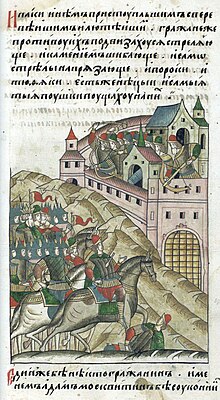Tokhtamysh
Tokhtamysh[1] (died 1405) was the prominent khan of the White Horde, who briefly unified the White Horde and Blue Horde subdivisions of the Golden Horde into a single state. He was a descendant of Genghis Khan's eldest grandson, Orda Khan or his brother Tuqa-Timur.

Early campaigns
Tokhtamysh appears in history in 1376, trying to overthrow his uncle Urus Khan, ruler of the White Horde, and fleeing to the great Timur. Tokhtamysh outlived Urus and both his sons and forcefully ascended the throne of the White Horde in 1378 with Timur's backing.
Tokhtamysh dreamed of emulating his ancestors and made plans to reunite the Ulus Jochi. In 1380, he invaded the Blue Horde by fording across the Volga. The ruler of the Blue Horde, Mamai, was killed shortly after the Battle of Kulikovo, making Tokhtamysh's victory over the horde all the easier.
Having united the Blue and White Hordes into the Golden Horde in 1382 Tokhtamysh led a successful campaign against Russia as a punishment for the Kulikovo defeat - setting back, though not ending, the Russian aspiration to free themselves of Mongol rule. In just six years, Tokhtamysh had reunified the Mongol lands from Crimea to Lake Balkhash.

Wars against Tamerlane
Believing he could emulate the successes of Genghis Khan himself, in 1385 Tokhtamysh, with an army of 50,000 (or five tumens), invaded Persia and took Tabriz. Returning north they took 200,000 slaves from Caucasus, including tens of thousands of azeri turks from the districts of Shirvan, Mugan, and Daghestan. As Tokhtamysh moved north from the Caucasus, Timur annexed Azerbaijan and Persia to his own expanding kingdom. Furious, Tokhtamysh turned back and made war on his former ally.
Eventually, Tokhtamysh conceded defeat and withdrew to the steppe. However, in 1387 he suddenly invaded Transoxiana, the heart of Timur's realm. Unfortunately for Tokhtamysh, heavy snow forced him back to the steppe.
In 1395, the scenario reached its climax as Timur attacked the Golden Horde and defeated Tokhtamysh at the Terek. Timur sacked the capital, Sarai Berke, vassalized the Golden Horde, and placed a puppet ruler, Koirichak, on the throne of Orda's Ulus and appointed Temur Qutlugh khan of the Horde.
Tokhtamysh escaped to the Ukrainian steppes and asked for help from the Grand Duke Vytautas of Lithuania. In the great Battle of the Vorskla River (1399) the combined forces of Tokhtamysh and Vytautas were defeated by two of Timur's generals, khan Temur Qutlugh and emir (murza, visir) Edigu. The defeated Tokhtamysh was killed in Tyumen by Edigu's men in 1405.
He was the last khan who minted coins with Mongolian script.
See also
Notes
- ^ The spelling of Tokhtamysh varies, but the most common spelling is Tokhtamysh. Toqtamysh, Toqtamış, Toqtamıs, Toktamys, Tuqtamış, and variants are also in use.
